NVIDIA Shield Review: At the Crossroads of PC and Mobile Gaming
by Brian Klug on July 31, 2013 12:14 AM ESTGPU Performance - 3DMark
The GPU performance story is finally a competitive one for NVIDIA. Although Tegra 4 lacks full OpenGL ES 3.0 compliance, it does finally dedicate enough SoC die area to GPU performance to compete with the likes of Apple and the iPad with Retina Display. We'll start with 3DMark, which is Android and Windows only at this point.
3DMark for Android features the Ice Storm benchmark and uses OpenGL ES 2.0. Ice Storm is divided into two graphics tests and a physics test. The first graphics test is geometry heavy while the second test is more pixel shader intensive. The physics test, as you might guess, is CPU bound and multithreaded. The overall score takes into account both graphics and physics tests. The benchmark is rendered to an offscreen buffer at 720p/1080p and then scaled up to the native resolution of the device being tested. This is a very similar approach we've seen by game developers to avoid rendering at native resolution on some of the ultra high resolution tablets. The beauty of 3DMark's approach here is the fact that all results are comparable, regardless of a device's native resolution. The downside is we don't get a good idea of how some of the ultra high resolution tablets would behave with these workloads running at their native (> 1080p) resolutions.
Here we see Tegra 4 in Shield outperforming all of the shipping players on Android, and virtually tying with Adreno 330 in Qualcomm's upcoming MSM8974 (Snapdragon 800 platform). Tegra 4's GPU performance is still no where near even Intel's HD 4000, but we're seeing massive improvements in raw FP throughput in ultra mobile GPUs. I'm very eager to see what's possible once Kepler makes its way into NVIDIA's mobile SoCs next year with Logan.
The 3DMark Physics test is also worth looking at as it shows a 36% increase in performance over four Krait 300 cores running at 1.5GHz. There are faster Krait 300s out there, but another 13% isn't enough to make up this gap. The Krait 400 comparison is much closer, but the Krait 400s have to be clocked at 2.3GHz to equal the performance of the 1.9GHz Cortex A15s. It remains to be seen which combination is ultimately lower power.
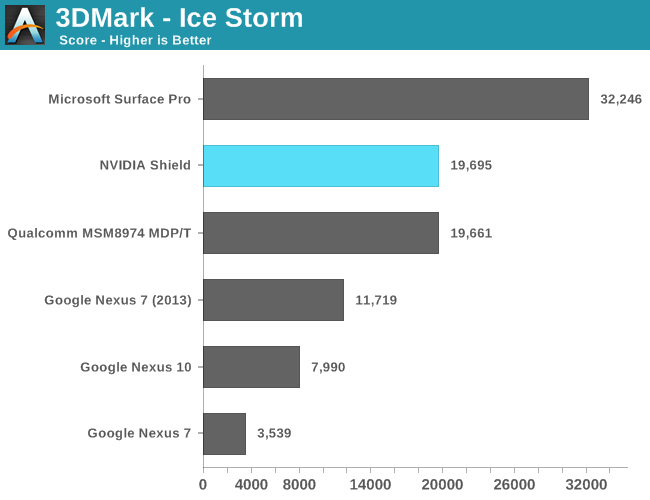

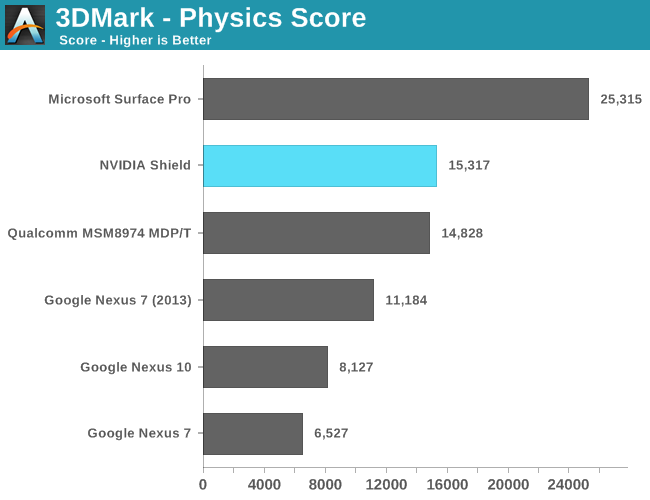
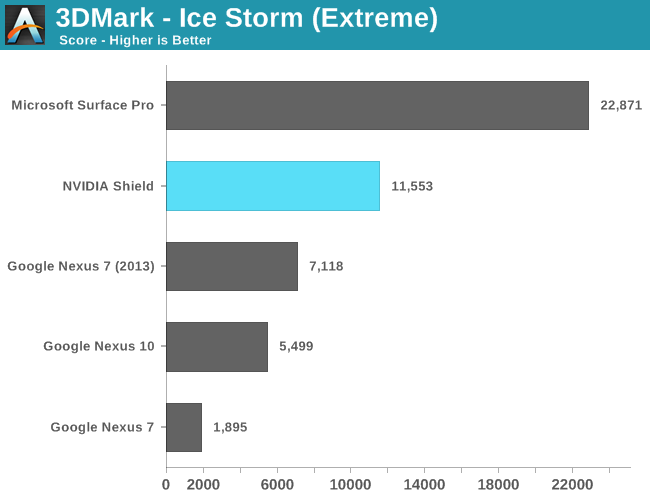
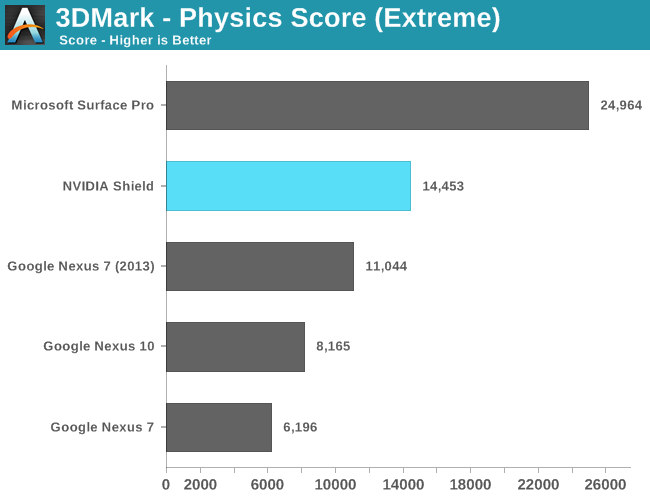

Basemark X
Basemark X is a new addition to our mobile GPU benchmark suite. There are no low level tests here, just some game simulation tests run at both onscreen (device resolution) and offscreen (1080p, no vsync) settings. The scene complexity is far closer to GLBenchmark 2.7 than the new 3DMark Ice Storm benchmark, so frame rates are pretty low.
In both tests, NVIDIA posts big gains over anything presently shipping from the Android camp. Adreno 330 pulls ahead on a level playing field, holding a 24% performance advantage over Tegra 4.
I would've loved to have seen this sort of competition from NVIDIA back when the iPad 4 launched, but it's at least good to see NVIDIA move from being a value player with Tegra 3 to a high performance contender with Tegra 4.
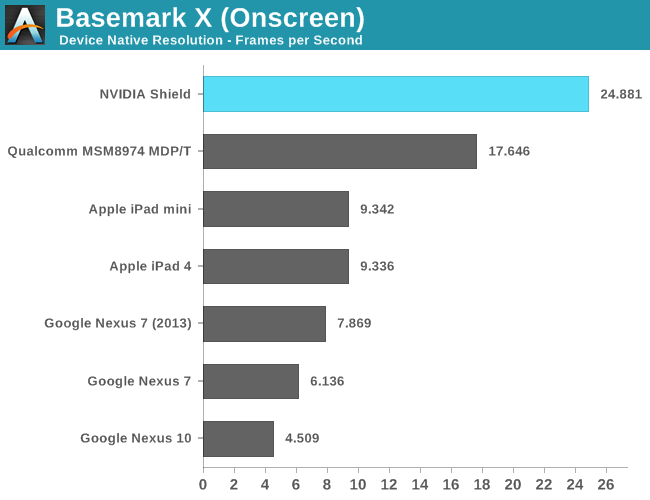











134 Comments
View All Comments
chizow - Wednesday, July 31, 2013 - link
Thanks, I'll have to keep an eye out for some info from users/reviews about streaming functionality. I was specifically interested in Windows Media Extender functionality to playback encrypted/premium cable TV from a cable card tuner, and it looks like XBMC may do the trick. Just not sure if the Android version supports this, or if the Android version of XBMC runs on Shield (it should since it's full Android 4.2.1).This video indicates it may be possible to stream cable card content to XBMC, but it looks like Windows version: http://www.youtube.com/watch?v=0aFTl3wYf04
SlitheryDee - Wednesday, July 31, 2013 - link
I'm pretty intrigued by this product. With the delay of tegra 4 and the presence of cheaper dedicated gaming systems with far more titles available to them, I have to think that this iteration was focused on ironing out the bugs in the design rather than setting the world on fire with sales. Just getting it out there, making people aware of it, and starting up the development of a decent number of games with the shield in mind would have to be enough to call the first run a success IMO. I don't know how Nvidia could have expected any more than that when thrusting a gamepad oriented android device into a touch-centric game world. I like that it was well executed, and I hope they go ahead with the next version with a (hopefully on time) tegra 5.et20 - Wednesday, July 31, 2013 - link
Thanks for the review.It's a really nice surprise to see nvidia deliver such a well balanced and put together product.
Let's hope that it will spur availability of high quality games.
Hrel - Wednesday, July 31, 2013 - link
Frankly this is a nice little device that does a lot of things right. Perhaps I'll pick one up when they do a revision featuring Nvidia's newest mobile GPU. That is of course the downside to devices this integrated (mobile); no upgrade ability. Upgrade ability is really the primary thing that I think is stopping gaming from moving to mobile devices for real. Once the product cycles slow down, which they're already doing, we should see mobile gaming really start to catch on and devices like this actually start to sell well.For now, no 802.11ac = not even the POSSIBILITY of me purchasing.
dbx81 - Wednesday, July 31, 2013 - link
shield + chromecast seems like a good combo right away, doesn't it?rwei - Wednesday, July 31, 2013 - link
I'd rather have a SwitchbladeSuvorov Sulla - Wednesday, July 31, 2013 - link
I know Brian can't do it because he is writting an official review and all that jazz but I REALLY wanted to see someone using a SNES and a PSP emulator on this thing. I would be honestly interested if it works well.thesavvymage - Wednesday, July 31, 2013 - link
I cant speak for PSP as I've never tried it, but snes emulation with a ps3 controller works flawlessly on my Nexus 4. This thing is more powerful in every way, so it should be pretty amazing.nafhan - Wednesday, July 31, 2013 - link
So... I'd be really interested in seeing a "battery life while streaming a PC game" test. I'm guessing something like the web browsing battery life -30%.Actually, a streaming video playback test might be interesting to see in general.
cmikeh2 - Wednesday, July 31, 2013 - link
I think it will be well above that. With the web browsing test there's a lot of CPU activity but when doing the remote PC gaming all it is doing is play an H.264 video from the network. I see it as pretty much in the middle of the web browsing test and the H.264 test.